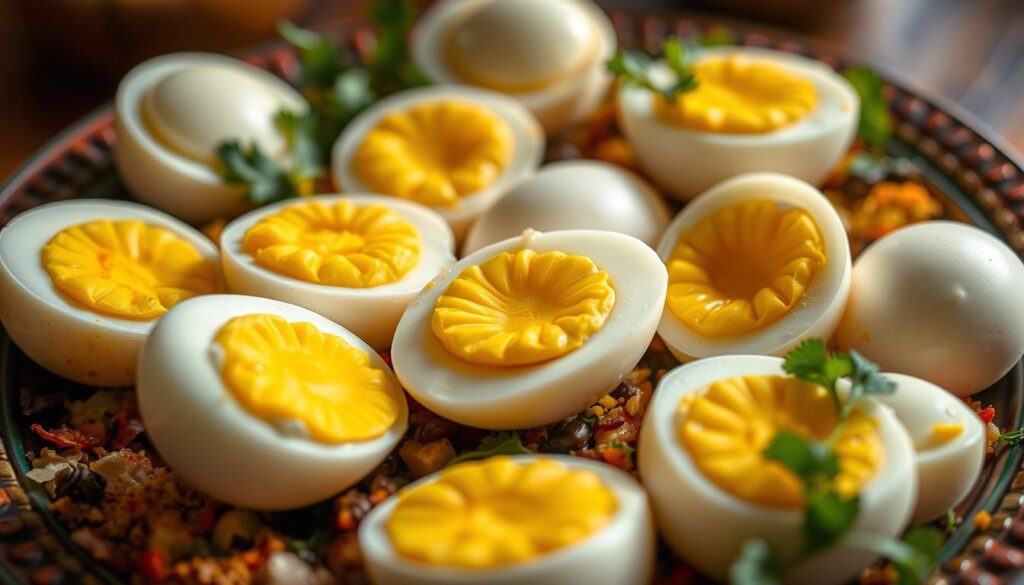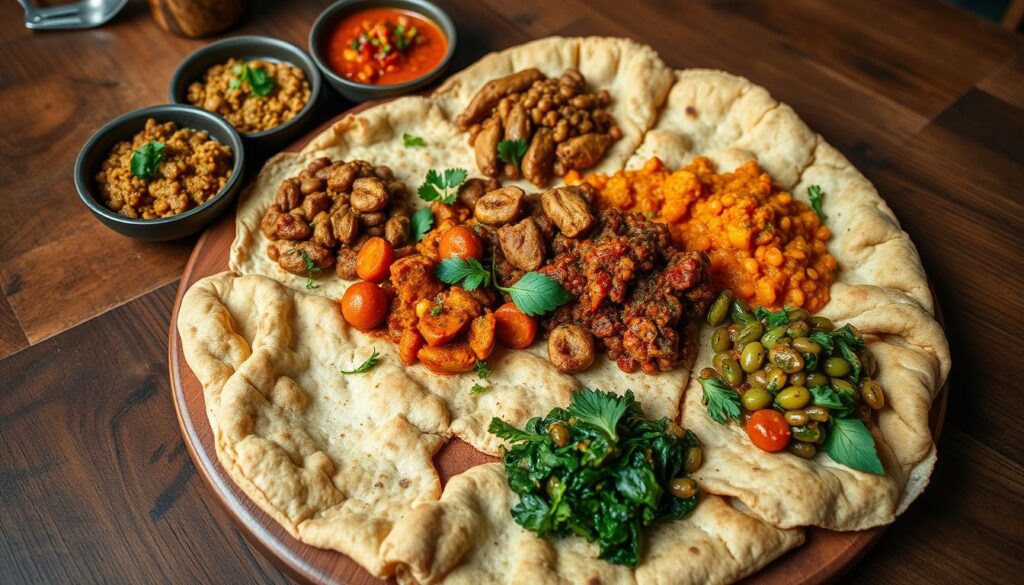Imagine a rich, aromatic stew that takes you to Ethiopia. This is Doro Wat, a dish loved by many. When I cook it, the smell of spices and chicken makes me think of Addis Ababa.
Doro Wat is not just a recipe. It’s a tradition passed down for generations. It celebrates Ethiopia’s rich culture. In this guide, we’ll explore how to make this amazing dish. You’ll learn about the ingredients and cooking techniques that make it special.
Introduction to Ethiopian Doro Wat
Ethiopian food is known for its bright tastes and deep traditions. At its core is Doro Wat, a spicy chicken stew loved by Ethiopians. It’s more than food; it’s a celebration of Ethiopian culture and community.
Cultural Significance in Ethiopian Cuisine
Doro Wat shows the strong bond between food and Ethiopian identity. It’s served at big events like holidays and weddings. Sharing Doro Wat around a mesob (a traditional table) brings people together.
Traditional Serving Customs
Doro Wat comes with injera, a special flatbread. People tear injera to pick up the stew and chicken. This way of eating is key to the Ethiopian dining experience.
Doro Wat and injera are loved at any gathering. They show the heart of Ethiopian food culture and the joy of eating together.
Essential Ingredients for Perfect Doro Wat
Making a real doro wat needs the right ingredients. At the center are spices, aromatics, and key parts that make it taste special.
The base of doro wat is berbere spice mix. It’s made from chili peppers, ginger, garlic, and spices. Also, niter kibbeh, a spiced butter, adds richness.
Here are more things you need for the best doro wat:
- Onions, caramelized to a deep, golden hue
- Garlic, finely minced to release its aromatic essence
- Ginger, freshly grated to impart a warm, slightly peppery note
- Chicken, typically bone-in thighs or drumsticks for maximum flavor
- Hard-boiled eggs, a traditional accompaniment
- Lemon or lime wedges, to provide a refreshing contrast
- Injera bread, the spongy, fermented flatbread that serves as the base
With these ingredients, you can make a delicious doro wat. It will take you to the heart of Ethiopian food.
| Ingredient | Purpose |
|---|---|
| Berbere Spice Blend | The signature spice blend that provides the distinctive flavor |
| Niter Kibbeh | The fragrant spiced clarified butter that adds richness and depth |
| Onions | Caramelized to create a deep, flavorful base |
| Garlic | Finely minced to release its aromatic essence |
| Ginger | Freshly grated to impart a warm, slightly peppery note |
| Chicken | Typically bone-in thighs or drumsticks for maximum flavor |
| Hard-Boiled Eggs | A traditional accompaniment to the stew |
| Lemon or Lime | Provides a refreshing contrast to the rich, spiced flavors |
| Injera Bread | The spongy, fermented flatbread that serves as the base |
The Secret Behind Berbere Spice Blend
The secret to Ethiopian Doro Wat’s flavor is Berbere spice blend. It’s a mix of chili peppers, fenugreek, cardamom, and more. This blend adds heat, sweetness, and depth to the dish.
Making Homemade Berbere
Making your own Berbere spice blend is fun. It lets you adjust the flavors to your liking. Start with whole spices and toast them to bring out their flavor. Here’s a simple recipe:
- Ethiopian chili peppers (or a blend of ancho and cayenne peppers)
- Fenugreek seeds
- Cardamom pods
- Coriander seeds
- Cumin seeds
- Cloves
- Cinnamon sticks
- Paprika
- Ginger powder
- Garlic powder
- Salt
Spice Blend Proportions
The exact Berbere spice blend ratio can vary. Use about 1 part each of chili peppers, fenugreek, and cardamom. Then, adjust the other spices to taste. Find the balance that you like best.
Storage Tips
After blending your Berbere, store it in an airtight container. Keep it in a cool, dark place. This way, the spices will stay fresh for months. Enjoy the authentic flavors of Ethiopian cuisine whenever you want.
Preparing the Chicken for Doro Wat
Getting the chicken ready for Ethiopian Doro Wat is key. It makes the dish flavorful and tender. Follow a few easy steps to make sure your chicken is ready for the spices and flavors.
Start by picking good chicken thighs or a whole chicken cut into pieces. Rinse the chicken under cold water and dry it well with paper towels. This helps the marinade stick to the meat.
- In a big bowl, mix the chicken with fresh lemon juice and kosher salt. The lemon makes the meat tender, and the salt adds flavor.
- Massage the lemon and salt into the chicken. Make sure it’s evenly spread. Then, cover the bowl and chill the chicken for at least 30 minutes, or up to 2 hours. This lets the flavors mix well.
This way, your chicken will be tender and full of flavor. It will blend perfectly into the Doro Wat stew. This step is important for a true and tasty Ethiopian dish.
Mastering the Onion Base
Making the perfect caramelized onions is key to great Ethiopian Doro Wat. It’s all about slow cooking to bring out the onions’ hidden flavors.
Caramelization Techniques
To get caramelized onions, use slow heat. Slice onions thin for even cooking. Cook them in a big skillet or Dutch oven over low heat, stirring now and then.
This slow cooking lets onions turn sweet and rich. They become the flavor foundation for the dish.
Building Flavor Layers
Don’t rush the onions’ cooking. The slower they cook, the deeper their flavor gets. When they start to brown, raise the heat a bit.
Keep stirring to avoid burning. Wait for them to turn a deep brown. Then, they’re ready for the spices and seasonings.
| Technique | Time | Result |
|---|---|---|
| Slow Sautéing | 20-30 minutes | Soft, translucent onions |
| Continued Cooking | 30-45 minutes | Caramelized, golden-brown onions |
| Extended Caramelization | 45-60 minutes | Deep, mahogany-colored onions |
Learning to make caramelized onions is crucial. It brings out the best in Doro Wat. Your dish will taste richer and more authentic.
Hard-Boiled Eggs in Traditional Style
In Ethiopian cuisine, hard-boiled eggs are key in Doro Wat. They are seasoned with Berbere spice. This makes them a great protein source that goes well with the stew.
To make the eggs, cook them until they’re just right. Then, peel them to show off their bright yellow yolks. Put the eggs in the Doro Wat when it’s almost done. This lets them soak up the flavors and spices.
| Preparation Technique | Benefits |
|---|---|
| Peeling the Eggs | Allows the eggs to fully absorb the flavors of the Doro Wat |
| Cooking until Hard-Boiled | Provides a satisfying texture and protein addition to the stew |
| Adding during Final Cooking | Ensures the eggs are infused with the traditional Berbere spices |
The hard-boiled eggs add protein and look great in Doro Wat. The red stew and yellow eggs make a stunning dish. It shows off Ethiopia’s rich food culture.

Step-by-Step Cooking Process
Making an authentic Ethiopian simmering stew like Doro Wat needs care and patience. But the taste is worth it. Let’s go through the steps to make your Doro Wat a true treat.
Initial Preparation
Start by cleaning the chicken well, removing fat or skin. Dry the chicken with paper towels and put it aside. Then, chop the onions, garlic, and ginger finely. This makes them ready for sautéing.
Cooking Stages
- Heat oil in a big pot or Dutch oven over medium-high. Add chopped onions and cook until they’re soft and golden, about 15 minutes.
- When the onions are golden, add garlic and ginger. Cook for 2-3 minutes, stirring often to avoid burning.
- Add the Berbere spice blend and cook for another minute. This lets the flavors mix well with the oil.
- Put the chicken in the pot, making sure it’s covered by the onion mix. Cover the pot and lower the heat to low. Simmer the stew for 45-60 minutes. This makes the chicken tender and the sauce thick.
Final Touches
When the cooking time is almost up, taste the simmering stew. Add more Berbere spice, salt, or lemon juice if needed. Then, mix in the hard-boiled eggs gently. This lets them warm up before serving.
Serving Your Ethiopian Doro Wat
Diving into the rich culinary traditions of Ethiopia, the serving of Doro Wat is a true cultural experience. As you prepare to indulge in this flavorful dish, it’s important to understand the essential accompaniments and the etiquette that surrounds Ethiopian dining.
The cornerstone of any Doro Wat feast is the injera bread, a spongy, fermented flatbread. It serves as both a utensil and a base for the stew. Traditionally, a large round of injera is placed on a communal serving platter. The Doro Wat is ladled onto the center, surrounded by various side dishes such as lentils, sautéed greens, and spiced vegetables.
- Injera bread: The foundation of the meal, used to scoop up the stew
- Side dishes: Lentils, sautéed greens, spiced vegetables, and more to complement the Doro Wat
- Communal serving: The platter is placed in the center of the table for shared dining
In the spirit of Ethiopian dining etiquette, the Doro Wat is meant to be shared and enjoyed collectively. Guests gather around the platter, using their right hand to tear off pieces of injera and scoop up the stew. Conversation, laughter, and the savoring of each bite create a convivial atmosphere. This makes the Doro Wat experience a true celebration of community and culture.

As you delve into the flavors of Doro Wat, remember to slow down, savor the spices, and embrace the communal spirit. This makes this dish a cornerstone of Ethiopian cuisine. Bon appétit!
Making Perfect Injera Bread Accompaniment
No Ethiopian feast is complete without teff flour flatbread, injera. It’s a spongy, fermented bread. It’s key for dishes like Doro Wat. Learning to make injera is essential for a real Ethiopian meal.
Traditional Fermentation Process
The secret to great injera is fermentation. It’s made from teff flour, water, and a starter. The mix ferments for days, getting its tangy taste.
- Start with top-notch teff flour, the main ingredient in real injera.
- Mix flour, water, and starter, then ferment for 2-3 days at room temperature.
- This makes a sour, bubbly batter ready for cooking.
Cooking Methods
Cooking injera on a traditional mitad is a challenge. Pour the batter on the hot surface. Cook until the top is set and edges crispy.
| Cooking Technique | Tips for Success |
|---|---|
| Stovetop | Use a large, nonstick skillet or griddle at medium-low heat. Pour batter evenly and cover to steam the top. |
| Electric Griddle | Heat the griddle to 375°F. Pour batter in a circle, starting from the center. Cover and cook until edges are dry and top is set. |
With patience and practice, you’ll make injera bread. It will be light, spongy, and perfect with Doro Wat and other Ethiopian dishes.
Storage and Reheating Guidelines
To keep your leftover Ethiopian Doro Wat tasty and safe, follow these easy tips. Storing and reheating right is important. It helps keep the dish’s special flavors and spices.
Store leftover Doro Wat in a tight container in the fridge for 3 days. To reheat, use the stovetop on medium heat. Stir often until it’s hot all the way through. Don’t use the microwave, as it can make the dish dry and lose flavor. Serve hot for a taste of Ethiopia.
It’s also important to keep food safe. Refrigerate Doro Wat quickly and don’t leave it out for more than 2 hours. Reheating it well is key to kill bad bacteria. With these tips, you can enjoy the real taste of Ethiopian Doro Wat, even days later.





